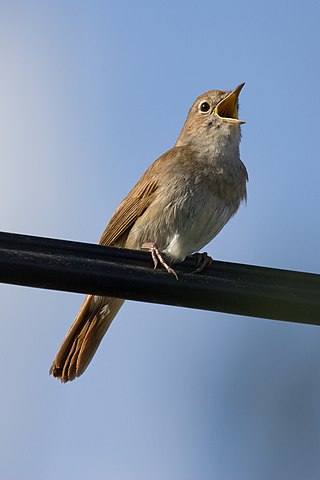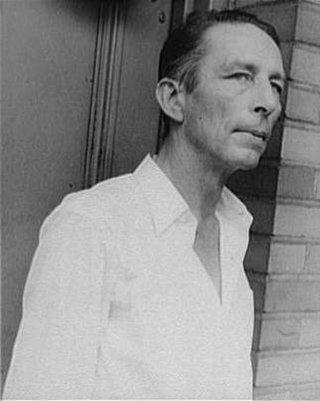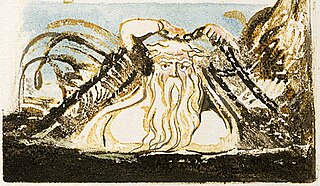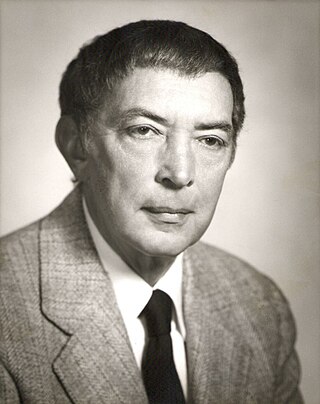
"Birds and Fishes" is a poem by the American and Californian writer Robinson Jeffers. It is included in The Beginning and the End and Other Poems, published posthumously in 1963.

"Birds and Fishes" is a poem by the American and Californian writer Robinson Jeffers. It is included in The Beginning and the End and Other Poems, published posthumously in 1963.
Jeffers wrote the poem in late 1954 or early 1955. [1]

The poem consists of 21 lines, of which the uneven lines generally have more syllables. It describes a yearly feeding frenzy in October, when fishes drawn to the shore attract large numbers of seabirds. The behavior of the birds is likened to a "witches' sabbath", "mob / Hysteria", and to humans "finding Gold in the street". The birds are attributed with envy, malice, greed, and a lack of pity for the fishes. The poet concludes that ideas of justice and mercy are concerns for neither animals nor God, and that life is characterized by hunger, terror and torment. He sees beauty in this. The quality of the scene described is not related to human concerns of "mercy", "mind" or "goodness", but to "the beauty of God". [2]
"Birds and Fishes" presents a clear example of how Jeffers viewed nature in his late nature poetry. In his early works, he expressed a worldview close to transcendentalism, and treated nature as a metaphor for human concerns. In the later works, humanity and human concerns are instead metaphors for nature. [3] In "Birds and Fishes", the poet is ironic when he anthropomorphizes the feasting birds and attributes sins and hysteria to their behavior. [4] Robert Zaller writes that "in the first part of 'Birds and Fishes', Jeffers almost presents a satiric account of what nature would look like if seen in terms of human behavior". [5] In the concluding lines the irony is gone. The poem maintains that life on earth is not concerned with "justice and mercy", but reflects a harsh beauty. This is in line with the non-anthropocentric worldview which Jeffers had labeled inhumanism. [4]
"Birds and Fishes" appeared in 1963, the year after Jeffers died, as the concluding poem in the collection The Beginning and the End and Other Poems, published by Random House. The same year it also appeared in Robinson Jeffers: Selected Poems from Random House and Poetry in Crystal from Steuben Glass Works. [6] In 1987, the poem was included in Random House's Rock and Hawk: A Selection of Shorter Poems by Robinson Jeffers. [6]
Poetry in Crystal was a collaboration between Steuben Glass and the Poetry Society of America where 31 artists were commissioned to create glass sculptures based on new poems. The writers were selected by the Poetry Society and received an honorarium of $250. Their identities were not revealed to the artists until afterwards. The commissions were made in 1961, and "Birds and Fishes" became the basis for a work with glass design by Donald Pollard and engraving design by Robert Vickrey. [7] [8] The collection was unveiled on April 18, 1963 at Steuben's gallery on Fifth Avenue in New York City, after which all the poems were published in a book with full-page photogravure images of the sculptures. The sculpture based on "Birds and Fishes" is in the collection of Sunnylands in Rancho Mirage, California. [8]

Gary Snyder is an American poet, essayist, lecturer, and environmental activist. His early poetry has been associated with the Beat Generation and the San Francisco Renaissance and he has been described as the "poet laureate of Deep Ecology". Snyder is a winner of a Pulitzer Prize for Poetry and the American Book Award. His work, in his various roles, reflects an immersion in both Buddhist spirituality and nature. He has translated literature into English from ancient Chinese and modern Japanese. For many years, Snyder was an academic at the University of California, Davis, and for a time served as a member of the California Arts Council.

The common nightingale, rufous nightingale or simply nightingale, is a small passerine bird best known for its powerful and beautiful song. It was formerly classed as a member of the thrush family Turdidae, but is now more generally considered to be an Old World flycatcher, Muscicapidae. It belongs to a group of more terrestrial species, often called chats.

"Ode to a Nightingale" is a poem by John Keats written either in the garden of the Spaniards Inn, Hampstead, London or, according to Keats' friend Charles Armitage Brown, under a plum tree in the garden of Keats' house at Wentworth Place, also in Hampstead. According to Brown, a nightingale had built its nest near the house that he shared with Keats in the spring of 1819. Inspired by the bird's song, Keats composed the poem in one day. It soon became one of his 1819 odes and was first published in Annals of the Fine Arts the following July. The poem is one of the most frequently anthologized in the English language.

Steuben Glass is an American art glass manufacturer, founded in the summer of 1903 by Frederick Carder and Thomas G. Hawkes in Corning, New York, which is in Steuben County, from which the company name was derived. Hawkes was the owner of the largest cut glass firm then operating in Corning. Carder was an Englishman who had many years' experience designing glass for Stevens & Williams in England. Hawkes purchased the glass blanks for his cutting shop from many sources and eventually wanted to start a factory to make the blanks himself. Hawkes convinced Carder to come to Corning and manage such a factory. Carder, who had been passed over for promotion at Stevens and Williams, consented to do so.

John Robinson Jeffers was an American poet, known for his work about the central California coast. Much of Jeffers's poetry was written in narrative and epic form. However, he is also known for his shorter verse and is considered an icon of the environmental movement. Influential and highly regarded in some circles, despite or because of his philosophy of "inhumanism", Jeffers believed that transcending conflict required human concerns to be de-emphasized in favor of the boundless whole. This led him to oppose U.S. participation in World War II, a stance that was controversial after the U.S. entered the war.
Stanford University Press (SUP) is the publishing house of Stanford University. It is one of the oldest academic presses in the United States and the first university press to be established on the West Coast. It is currently a member of the Association of University Presses. The press publishes 130 books per year across the humanities, social sciences, and business, and has more than 3,500 titles in print.
William "Bill" Everson, also known as Brother Antoninus, was an American poet, literary critic, teacher and small press printer. He was a member of the San Francisco Renaissance.
Nathaniel Tarn is a French-American poet, essayist, anthropologist, and translator. He was born in Paris to a French-Romanian mother and a British-Lithuanian father. He lived in Paris until the age of seven, then in Belgium until age 11; when World War II began, the family moved to England. He emigrated to the United States in 1970 and taught at several American universities, primarily Rutgers, where he was a professor from 1972 until 1985. He has lived outside Santa Fe, New Mexico, since his retirement from Rutgers.
"The Convergence of the Twain (Lines on the loss of the Titanic)" is a poem by Thomas Hardy, published in 1912. The poem describes the sinking and wreckage of the ocean liner Titanic. "Convergence" consists of eleven stanzas (I to XI) of three lines each, following the AAA rhyme pattern.
Nationality words link to articles with information on the nation's poetry or literature.
Robert Michael Zaller is an American author whose works include volumes of history, criticism, and verse. He is Drexel Distinguished University Professor of History Emeritus, and has been active as an opponent of the death penalty.

Morley Baer, an American photographer and teacher, was born in Toledo, Ohio. Baer was head of the photography department at the San Francisco Art Institute, and known for his photographs of San Francisco's "Painted Ladies" Victorian houses, California buildings, landscape and seascapes.

John Felstiner, Professor Emeritus of English at Stanford University, was an American literary critic, translator, and poet. His interests included poetry in various languages, environmental and ecologic poems, literary translation, Vietnam era poetry and Holocaust studies. John Felstiner died in February 2017 at the age of 80. He had been suffering from the effects of progressive aphasia at his time of death, at a hospice near Stanford.

"The Human Abstract" is a poem written by the English poet William Blake. It was published as part of his collection Songs of Experience in 1794. The poem was originally drafted in Blake's notebook and was later revised for as part of publication in Songs of Experience. Critics of the poem have noted it as demonstrative of Blake's metaphysical poetry and its emphasis on the tension between the human and the divine.

Radcliffe Squires was an American poet, writer, critic, and academic. He published several well-regarded books of poetry, as well as biographical and critical works which focused on highly acclaimed 20th-century writers.
The Dark Watchers is a name given to a group of entities in California folklore purportedly seen observing travelers along the Santa Lucia Mountains.
Cho Yongmee is a South Korean poet. She writes poems based on her experience of nature and landscapes through her various senses such as vision, touch and hearing rather than using the abstract and notional mode of expression. Her poems show different aspects of normal phenomena from her sensitive perspective.
"Shine, Perishing Republic" is a poem by the American writer Robinson Jeffers, first published in 1925 in the collection Roan Stallion, Tamar, and Other Poems. It describes an increasingly corrupt American empire, which it advises readers to view through the naturalizing perspective of social cycles. Jeffers wrote two companion poems in the 1930s: "Shine, Republic" and "Shine, Empire".
Tamar is an epic poem by the American writer Robinson Jeffers, first published in 1924. A tale of incest and violence, it follows Tamar Cauldwell, the daughter of a Californian ranch family, as she experiences transgression, hatred, and destruction. Tamar was the first unrhymed narrative poem Jeffers wrote. The story makes references to the biblical Books of Samuel and deals with themes of nature and corruption.

"The Black Vulture" is a sonnet by American poet George Sterling first printed in March 1910. The poem was cited by Thomas E. Benediktsson in his book George Sterling as “a sonnet which became Sterling’s most consistently praised and most anthologized poem.” Poet and critic William Rose Benét wrote: “As for ‘The Black Vulture,’ I think it is one of the finest sonnets in the language.” The New York Times said: “No finer sonnet has been written for many a day.” In American Literature, professor Robert G. Berkelman called it “one of Sterling’s most enduring achievements and certainly among the memorable sonnets in our literature.” After the poem’s first book publication in 1911, reprints of “The Black Vulture” in newspapers, magazines, and books have kept it almost continually in print for more than a hundred years.
{{cite book}}: CS1 maint: location missing publisher (link)